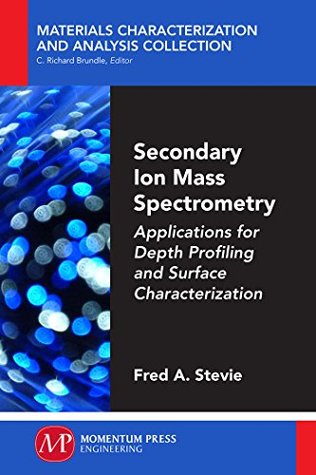Download Secondary Ion Mass Spectrometry: Applications for Depth Profiling and Surface Characterization - Fred Stevie | PDF
Related searches:
Novel Secondary Ion Mass Spectrometry Methods for the - Frontiers
Secondary Ion Mass Spectrometry: Applications for Depth Profiling and Surface Characterization
Secondary Ion Mass Spectrometry for Biological Applications
Secondary Ion Mass Spectrometry: An Introduction to Principles and
Matrix-enhanced secondary ion mass spectrometry: a method for
Cluster Secondary Ion Mass Spectrometry: Principles and
Secondary ion mass spectrometry (sims) secondary ion mass spectrometry (sims) detects very low concentrations of dopants and impurities. The technique provides elemental depth profiles over a wide depth range from a few angstroms (å) to tens of micrometers (µm).
Mass spectrometric imaging of brain tissue by time-of-flight secondary ion mass spectrometry - how do polyatomic primary beams c 60 +� ar 2000 +� water-doped ar 2000 + and (h 2 o) 6000 + compare. Rapid communications in mass spectrometry 2015, 29 (20)� 1851-1862.
Secondary ion mass spectrometry is a highly sensitive technique for investigating the surface chemistry of samples.
Sims 23 will provide a forum for colleagues from academic, industrial, and national laboratories throughout the world to exchange results and new ideas on secondary ion mass spectrometry and related techniques. The conference will cover advancements of scientific knowledge from fundamentals to applications.
Secondary ion mass spectrometry: a practical handbook for depth profiling and bulk impurity analysis shows sims analysts how to acquire improved data and gain a better understanding of that data. This handbook is unique—the information is not found elsewhere in book form, and, for the most part, is not published in the literature.
Secondary-ion mass spectrometry (sims) is a technique used to analyze the composition of solid surfaces and thin films by sputtering the surface of the specimen with a focused primary ion beam and collecting and analyzing ejected secondary ions.
Understand the principles of secondary ion mass spectrometry (sims).
Serves as a practical reference for those involved in secondary ion mass spectrometry (sims) • introduces sims along with the highly diverse fields ( chemistry,.
Secondary ion mass spectrometry consists of analyzing these secondary ions with a mass spectrometer.
Secondary ion mass spectrometry consists of analyzing these secondary ions with a mass spectrometer. Secondary ion emission by a solid surface under ion bombardment supplies information about the elemental, isotopic and molecular composition of its uppermost atomic layers.
High-resolution secondary ion mass spectrometry reveals the contrasting subcellular distribution of arsenic and silicon in rice roots.
Secondary ion mass spectrometry (sims) allows the measurement of isotopic, elemental, and molecular information from the surface of solid samples.
Secondary ion mass spectrometry (sims) is an analytical technique that can be used to characterize the surface and near surface (~30 µm) region of solids and the surface of some liquids.
Secondary ion mass spectrometry (sims) is a technique used to analyze compositions of thin films and surfaces by using a focused primary ion beam to sputter the surface of a sample and analyze the ejected secondary ions. Sims is a qualitative technique nominally but, if combined with standards, can be considered a quantitative technique.
Secondary ion mass spectrometry (sims) is an analytical technique that detects very low concentrations of dopants and impurities. It can provide elemental depth profiles over a depth range from a few nanometers to tens of microns. Sims works by sputtering the sample surface with a focused beam of primary ions.
Secondary ion mass spectrometry (sims) is an information-rich tool that the surface analyst can bring to bear on a biomedical problem. Sims, in the static mode, produces a mass spectrum of the outermost 1–2 nm of a surface. Like esca, it requires complex instrumentation and an ultrahigh vacuum chamber for the analysis.
Explores the impact of the latest breakthroughs in cluster sims technology cluster secondary ion mass spectrometry (sims) is a high spatial resolution imaging mass spectrometry technique, which can be used to characterize the three-dimensional chemical structure in complex organic and molecular systems.
Secondary ion mass spectrometry (sims) is a surface-analysis technique that increasingly is being used in a wide variety of applications, including the study of semiconductor thin films, metallurgical grain structures, polymers, and organic materials.
One of the most sensitive analytical techniques for advanced material research that can also detect hydrogen is secondary ion mass spectroscopy (sims).
Secondary ion mass spectrometry (sims) is a technique capable of providing information about the elemental and isotopic.
Magnetic sector secondary ion mass spectrometry (sims) generates isotopic and elemental information from solid surfaces with depth profiling capabilities to measure the concentration of isotopes and elements as a function of depth into the film.
Secondary ion mass spectrometry (sims) is a surface technique with high surface sensitivity, high spatial resolution chemical imaging and unique depth profiling.
Magnetic sector secondary ion mass spectrometry (sims) generates isotopic and elemental information from solid surfaces with depth.
A new methodology, matrix-enhanced secondary ion mass spectrometry (me- sims), is reported for the molecular analysis of biomaterials.
30 apr 2020 dirk schaumlöffel introduces the jaas themed collection on secondary ion mass spectrometry for biological applications.

Post Your Comments: